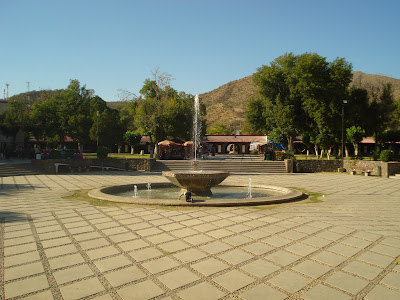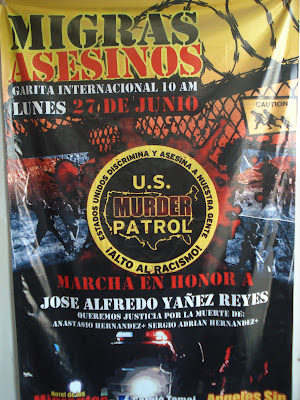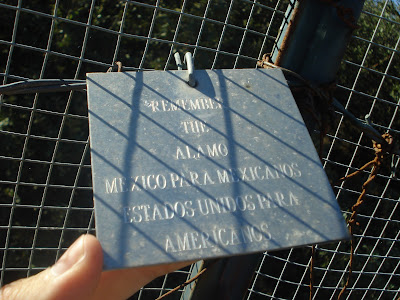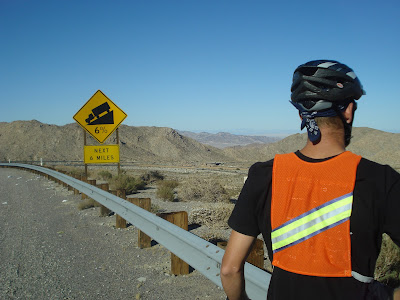Ever since reading
Targeted: National Security and the Business of Immigration, which briefly mentions Altar, Sonora as a major waypoint for migrants, I have wanted to visit. This is why we dipped south of the border and missed a few border towns along the way--all for Altar, and it was worth it.
We were warned that Altar is completely controlled by narcotraffickers and our presence would probably be known even before we arrived. This fact was a little intimidating at first, but we were really fascinated by our time in Altar and nothing bad happened to us while there.
Eighty percent of Altar's economy is based on migrants. At its highest point, between 2002-2004, 3,500 migrants were passing through Altar everyday.
Every Single Day. Since then, the numbers have decreased dramatically (but still at least in the hundreds per day), due to a poor economy in the U.S., heightened border enforcement and as narcotraffickers have become more involved in the business of smuggling people in the area. Now, often, the coyotes/polleros/guides/smugglers who assist in crossing migrants work for the narcos and, more regularly, people are convinced or forced to be burreros--folks who lug marijuana to the U.S. on their backs. In a very systematic process they have set up in recent years, aside from what they pay to be smuggled into the U.S., every migrant must pay a fee to the narcos/mafia/"duenos del terreno/owners of the land."
There are vans that drive migrants from Altar, Sonora to Sasabe, Sonora, the border town almost 60 miles north. The drivers of the vans charge the fee for the narcos, 1200-1500 pesos for Mexicans, 2000 pesos for Central Americans ($100-125, $165 USD). When the fee is collected, the driver calls their mafia contact, giving that person the number of the van and how many people will be crossing. On the journey, the van will get stopped at a checkpoint of sorts and another mafia member will check the van number and the number of people who the driver reported had paid. If the number is the same, the van continues to the border. If there is one person too many, the van driver will likely get beat up and the extra person may be kidnapped, his/her family extorted for the money owed and more.
 |
| Van which transports migrants between Altar and Sasabe |
Before we knew ANY of that, we arrived in Altar. The shelter we stayed at opened at 5:00 and we were early, so I ducked into an internet cafe, while Eric watched the loaded bikes outside and read his book. Eric saw a numbered van pull in and the driver and two women walk toward the internet cafe. The driver lingered outside, waiting while the women used the computers, and read the bumper stickers on our bikes before striking up a conversation with Eric. He talked freely of his work the past 10 years as a van driver--"it's just like driving a taxi," he said several times. He said it was recently very dangerous as the area became disputed in the drug world and two cartels began to duke it out. Many people were killed , though it was hardly reported, but now that the area is completely controlled by one cartel, it is much safer.
The driver said that the mafia controls everything and they keep everyone in line. He didn't tell Eric how they charged the migrants, we learned that later, but he said that all the money made off the migrants goes through the cartels. He quoted the mafia saying, "el dinero es para mi y para el pueblo--nadie mas" meaning the money earned from the migrants is for the people employed/controlled by the narcos in the migrant industry and for the narcos themselves--no one else. This means, if a police officer is found by the mafia to be stealing from a migrant, an all too common practice, the police officer will be punished. The driver said he has never witnessed the mafia mistreating the migrants, though he has witnessed them beating up coyotes who have misbehaved. What an interesting person to chat with, having spent less than an hour in the city!
We stayed at CCAMYN - the Centro Comunitario de Atencion a Migrantes y Necesitados, which is the migrant shelter in the area, run by the parish. The shelter started 10 years ago, and a year before that, congregants gave food to migrants in the plaza every Sunday after mass. The shelter opens to men and women each night and welcomes people from 5-6pm. A dinner is served in a big comedor that is filled with migrant themed art and educational posters. After dinner, guests are shown to the dormitories where they can shower and rest the night. There is also a big courtyard used for educational purposes to show the guests what kind of flora they will find in the desert, along with an example water barrel, which many humanitarian organizations fill on the desert trails. If available from donations, the guests may also receive clothing and/or toiletries. In the morning, another volunteer wakes the migrants up and invites them to breakfast. Then they are out the door and the whole place is closed up by 7:30am. It is run entirely by volunteers who live in the city and no volunteer even stays overnight.
 |
| CCAMYN- the migrant shelter where we stayed |
 |
| The courtyard at CCAMYN has examples of cactus found in the desert and a water barrel to educate the guests |
 |
| Map of Arizona - red dots are places remains have been found, though many more have died since this poster was made, and the semi circles show one, two, three days of walking. Some migrants walk all the way to Phoenix - 150 miles! On the bottom, the poster says "Don't go! There is not enough water! It is not worth it!" |
 |
| Cross at CCAMYN draped with names of migrants who have died crossing |
It was a beautiful space and we were welcomed by several volunteers who very graciously sat with us before dinner and told us of the work and the city. Marcos, the evening volunteer, and long-term volunteers Belen and Teresa, told us some facts and figures about the city and about the recent change in control of the area. We also chatted about the struggle to keep out coyotes and burreros. After a fascinating discussion, we ate dinner and chatted with that evening's 5 male guests before heading to bed nice and early.
 |
| Marcos, who welcomes guests each night |
I thought, in a city where 3,500 people used to cross everyday, the migrant shelter would be overflowing, but the volunteers told me that even when numbers in the city were that high, the most they saw were 30-40 people per night. This is because most people who come to Altar have already paid a coyote and that coyote has his or her connections in area, likely staying at one of the many cheap hotels that fill the town. So, most of the people staying at the shelter have been abandoned or assaulted by their coyotes or they were deported recently and are preparing to try again.
We spent the next full day in Altar, just walking around, observing and chatting with people. I don't even think you have to pay attention to see that everything is catered to migrants. The small town is full of restaurants and hotels--most with names like Hotel La Veracruzana, Restaurante Chiapas--trying to lure in migrants with names from their home states. The street markets sell camouflage backpacks, socks, ski mask and glove sets. Even in the grocery store, we pointed out displays of cans of pop-top tuna and Gatorade.
 |
| This restaurant tries to lure in migrants from the southern state of Chiapas |
 |
| Markets catering to migrants |
Walking around Altar, you just see a lot of men. Lots of them with backpacks, but some too nice looking for town--perhaps coyotes? While in many towns in Mexico, there is a void of young men, Altar is chock full of them. We saw Greyhound-style buses pause at the plaza several times per day to drop off ever more men and at one point, we saw a group of about 30-40 men walking past the main plaza.
We only saw one woman who appeared to be a migrant during our time in Altar. I would bet there were more there, but they probably take greater care to not be seen, as female migrants are so likely to be abused and assaulted on their journey.
 |
| The plaza of Altar, where migrants and coyotes mingle and hang out. |
A couple of women we did talk to were surveying the migrants, for data collection by the Colegio de la Frontera Norte. The COLEF has paid people to talk to Mexican migrants every day all along the border for the last twelve years and have published many reports
here. They do not ask the migrants name or address or phone number, but instead want to know where the migrant is going, if they have a job or house or family there, if they have a job or house or family in Mexico, have they crossed before, were they deported, what is their level of education, etc. I am so glad to see that this institute has been doing this research and it sounds like they must have an incredible amount of data available.
I spent a good amount of the day in internet cafes, and one notable observation from my time inside was witnessing many children playing super-violent video games that were set in the desert. I have debated with many friends about the effects of violent video games, but it felt different to be in a narco-occupied area, knowing that with the current economy in Mexico, many of these kids may see working for the narcos as their only option. And in hearing about atrocities committed against migrants, one has to wonder how they can be so dehumanized, how violence can be so normalized. Do these games really have no effect?
 |
| Child in internet cafe, playing violent video games set in the desert |
That night at CCAMYN only two guests stayed at the shelter besides us (there were a few more at dinner who were overheard talking about carrying drugs so they were asked to leave). The volunteers and guests were so kind to us, blessing our journey and joking that they were going to grab bikes and join us.
 |
| The Friday night volunteer cooks at CCAMYN, Gloria and Catalina |
 |
| Migrants attended: 22,272 |
It was a really interesting day and a half in Altar. Eric and I are really glad we were able to spend time there, that CCAMYN was willing to host us, and that so many people were willing to let us sit and listen to their stories and insights.
 |
| "A los Caidos en los Desiertos de la Muerte/To the Fallen in the Deserts of Death" poem by Othon Perez |
I found this translation of the above poem on the
blog of Rick Ufford-Chase:
TO THE FALLEN IN THE DESERTS OF DEATH:
In memory of those who, when seeking a better life,
found only death,
In memory of those who risked risked everything and lost it,
Who went with hope in their eyes and challenge in their souls.
The sun calcified them, the desert devoured them,
and the dust erased their name and their face.
In memory of those who will never return
we offer these flowers . . .
To them, with respect, we say:
Your thirst, is our thirst.
Your hunger, is our hunger.
Your pain, is our pain.
Your discomfort, your bitterness, your agony
Are also ours.
We are a shout that demands justice. . .
In order that No One, ever again, will have to
Abandon their lands, their beliefs, their dead, their children
their parents, their family, their race, their culture, their identity. . .
We are a silence that has a voice . . .
In order that no one will have to look for their destiny in other lands.
In order that no one will have to go to the desert and be consumed by loneliness.
We are a voice in the desert that cries out:
Education for all!
Opportunity for all!
Work for all!
Bread for all!
Liberty for all!
Justice for all!. . .
We are a voice that the desert cannot drown. . .
In order that the country offers equality to all its children
The opportunity for a decorous and dignified life. . .
"For the right to live in Peace"
Mexico, Winter - 2004
Othon Perez (Poet)






























































